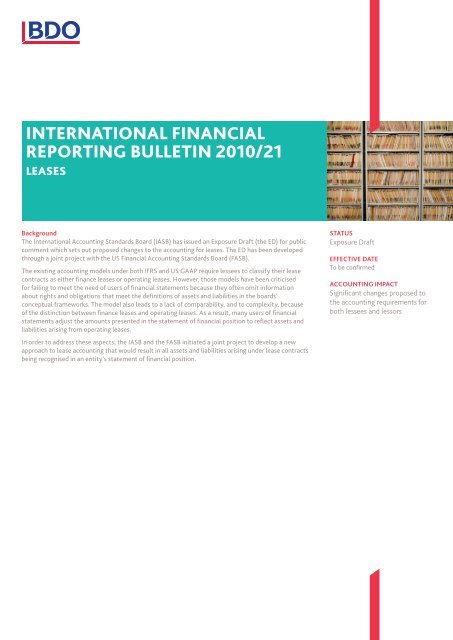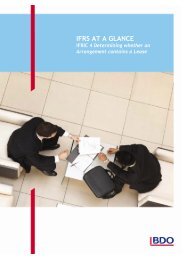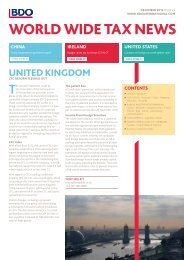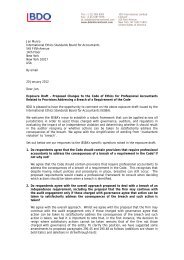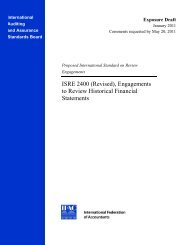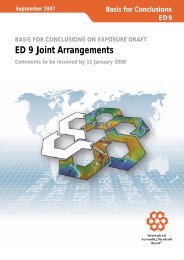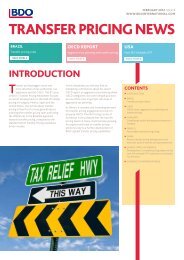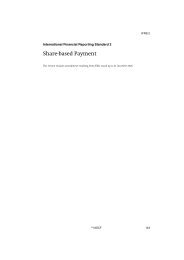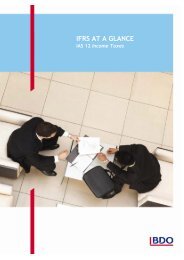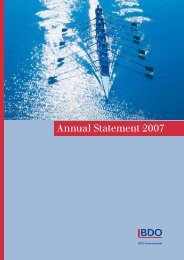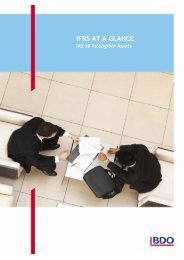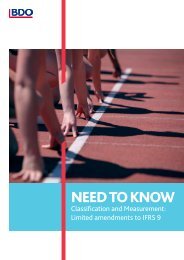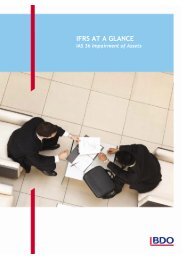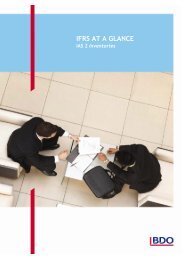Leases - BDO International
Leases - BDO International
Leases - BDO International
Create successful ePaper yourself
Turn your PDF publications into a flip-book with our unique Google optimized e-Paper software.
INTERNATIONAL FINANCIALREPORTING BULLETIN 2010/21LEASESBackgroundThe <strong>International</strong> Accounting Standards Board (IASB) has issued an Exposure Draft (the ED) for publiccomment which sets out proposed changes to the accounting for leases. The ED has been developedthrough a joint project with the US Financial Accounting Standards Board (FASB).The existing accounting models under both IFRS and US GAAP require lessees to classify their leasecontracts as either finance leases or operating leases. However, those models have been criticisedfor failing to meet the need of users of financial statements because they often omit informationabout rights and obligations that meet the definitions of assets and liabilities in the boards’conceptual frameworks. The model also leads to a lack of comparability, and to complexity, becauseof the distinction between finance leases and operating leases. As a result, many users of financialstatements adjust the amounts presented in the statement of financial position to reflect assets andliabilities arising from operating leases.In order to address these aspects, the IASB and the FASB initiated a joint project to develop a newapproach to lease accounting that would result in all assets and liabilities arising under lease contractsbeing recognised in an entity’s statement of financial position.STATUSExposure DraftEFFECTIVE DATETo be confirmedACCOUNTING IMPACTSignificant changes proposed tothe accounting requirements forboth lessees and lessors
2IFRS 2010/21 LEASESProposalsScopeThe ED proposes that lessees and lessors apply a right-of-use modelin accounting for all leases (including subleases), other than leases ofbiological and intangible assets, leases to explore for or use naturalresources, and leases of some investment properties (see below). Forleases that would be within the scope of the new IFRS, this meansthat:(a) a lessee would recognise an asset representing its right to use theleased (underlying) asset for the lease term (a ‘right-to-use’ asset)and a liability to make lease payments.(b) a lessor would recognise an asset representing its right to receivelease payments and deal with the underlying asset, as follows:(i) if there was not a transfer of significant risks or benefits of theunderlying asset, the lessor would recognise a lease liabilitywhile continuing to recognise the entire underlying asset (aperformance obligation approach); or(ii) if there was a transfer of significant risks or benefits of theunderlying asset, the lessor would derecognise the underlyingasset to the extent that it is transferred to the lessee, andcontinue to recognise a residual asset representing its rightsto the underlying asset at the end of the lease term (aderecognition approach).The proposals would apply to the initial measurement of allinvestment property that is held under a lease. However, after initialrecognition, if a lessee measured a right-of-use investment propertyasset in accordance with the fair value model, the lessee would applythe requirements of IAS 40 Investment Property when accounting forthe investment property asset and subsequent changes in the leaseliability to make lease payments would be recognised in profit orloss. If the lessee used the cost model, the right of use asset wouldbe accounted for in accordance with the new IFRS. If, after initialrecognition, a lessor of investment property (whether freehold orleasehold) chose to account for investment property using the fairvalue model then the lessor would apply the requirements of IAS 40,with changes in fair value being recognised in profit or loss. Leaseincome would be recognised on a straight line basis over the leaseterm. A lessor that used the cost model would recognise lease incomearising on investment property in accordance with the new IFRS.The following contracts, which represent a purchase or sale of anunderlying asset, would not be within the scope of the new IFRS:(a) a contract that results in an entity transferring control of theunderlying asset and all but a trivial amount of the risks andbenefits associated with the underlying asset to another entity; and(b) a lease after the lessee has exercised a purchase option specifiedin the lease. A contract ceases to be a lease when such an option isexercised as it becomes a purchase (by the lessee) and sale (by thelessor).Lessee AccountingRecognitionUnder the proposals, at the date of commencement of a lease a lesseewould recognise a right-of-use asset and a liability to make leasepayments. The date of commencement of a lease is the date on whichthe lessor makes the underlying asset available for use by the lessee.This may be different from the date of inception of the lease, which isused for measurement purposes (see below).Initial MeasurementAt the date of inception of a lease (being the earlier of the date of thelease agreement and the date of commitment by the parties to thelease agreement), a lessee would measure its obligation to make leasepayments at the present value of the lease payments, discountedusing the lessee’s incremental borrowing rate or, if it can be readilydetermined, the rate the lessor charges the lessee.The lessee’s incremental borrowing rate is the rate of interest that,at the date of inception of the lease, the lessee would have to payto borrow over a similar term, and with a similar security, the fundsnecessary to purchase a similar underlying asset.The right-of-use asset is measured at the amount of the obligationto make lease payments, plus any initial direct costs incurred by thelessee. Initial direct costs are those costs that are directly attributableto negotiating and arranging a lease, that would not have beenincurred had the lease transaction not been made.The present value of lease payments payable during the lease term iscalculated on the basis of expected outcome. The proposals note thatthis is the present value of the probability-weighted average of thecash flows for a reasonable number of outcomes, and clarify that it isnot necessary to assess every possible outcome. Amounts that wouldbe included in the assessment are an estimate of contingent rentalspayable, an estimate of amounts payable by the lessee (and notunrelated third parties) to the lessor under residual value guarantees,and an estimate of expected payments to the lessor under termoption penalties. Purchase options, and any amounts payable under apurchase option, are not included in determining the present value ofamounts payable under the lease.The lease term is the longest possible term that is more likely than notto occur, taking into account the effect of any options to extend orterminate the lease. This is determined by estimating the probabilityof occurrence for each possible outcome.The application guidance contains an example to illustrate how thelease term would be determined where a lease contains extensionoptions. The example considers a lease that has a non-cancellable10-year term, an option to renew for 5 years at the end of 10 years,and an option to renew for an additional 5 years at the end of 15 years.The probabilities for each term as follows:(a) 40% probability of 10-year term(b) 30% probability of 15-year term(c) 30% probability of 20-year term.The analysis notes that the lease term will be at least 10 years, withthere being a 60% probability that it will be 15 years but only a 30%probability that it will be 20 years. Consequently the lease term isdetermined to be 15 years.
IFRS 2010/21 LEASES 3Subsequent MeasurementAfter the date of commencement of the lease (being the date on whichthe lessor makes the asset available for use by the lessee), a lesseewould measure its obligation to make lease payments at amortisedcost using the effective interest method and the right-of-use asset atamortised cost (subject to impairment), unless it is revalued.The proposals would require a lessee to reassess the carrying amountof each of its lease obligations if facts or circumstances indicatethat there has been a significant change in them since the previousreporting period. Changes in obligations could arise as a result ofreassessments of the length of the lease term and/or contingentrentals and other amounts that may become payable. Where thereassessment resulted in a change in the amount payable, this changewould be split between amounts relating to the current or priorperiods (which would be charged or credited to profit or loss), andfuture periods (which would adjust the carrying amount of the right ofuse asset).As noted above, a lessee is permitted to measure a right-of-use assetat its revalued amount, less any amortisation and impairment lossesarising after that date. The requirements are consistent with thoseset out in IAS 16 Property, Plant and Equipment, in that all assets inthat class of property, plant and equipment would be required tobe revalued. However, in contrast to items of property, plant andequipment, the recognition of gains and losses on the revaluationof right of use assets would be in accordance with IAS 38 IntangibleAssets, although for the purposes of the revaluation itself the IAS 38requirement for an active market to exist for an asset would not apply.IAS 36 Impairment of Assets would be applied at each reporting dateto determine whether a right-of-use asset is impaired and for thepurposes of the recognition of any impairment loss.PresentationThe following items would be included in the statement ofcomprehensive income:––interest expense on the liability to make lease payments;––amortisation of the right-of-use asset;––any changes in the liability to make lease payments resulting fromreassessment of the expected amount of contingent rentals orexpected payments under term option penalties and residual valueguarantees relating to current or prior periods; and––impairment losses on a right-of-use asset, except to the extent thatanother IFRS requires or permits its inclusion in the cost of an asset.Lessor accountingUnder the proposals, a lessor would apply the performance obligationapproach to leases where it retains exposure to significant risksand benefits associated with (all of) the underlying asset, and thederecognition approach to leases where it does not.
4IFRS 2010/21 LEASESLessor - performance obligation approachRecognitionUnder the performance obligation approach, a lessor would notderecognise any part of the underlying leased asset.At the date of commencement of a lease (being the date on which thelessor makes the asset available for use by the lessee), a lessor wouldrecognise an asset representing its right to receive lease payments anda lease liability (the performance obligation), representing the lessorsobligation to permit the lessee to use the leased asset over the leaseterm. The term ‘performance obligation’ is used in the ED with themeaning proposed in the exposure draft Revenue from Contracts withCustomers.Initial MeasurementAt the date of inception of the lease (being the earlier of the date ofthe lease agreement and the date of commitment by the parties tothe lease agreement), a lessor would measure its right to receive leasepayments at the present value of the lease payments, discountedusing the rate that the lessor charges the lessee, plus any initialdirect costs incurred by the lessor. The discount rate could be thelessee’s incremental borrowing rate, the rate implicit in the lease or(for property leases) the yield on the property. Initial direct costsare defined in a similar way to those for lessees, being costs that aredirectly related and essential to acquiring or originating the leasewhich would not have been incurred had the lease transaction notbeen made.The lease liability would be measured at the calculated amount of theright to receive lease payments.Subsequent MeasurementAfter the date of commencement of the lease (being the date onwhich the lessor makes the asset available for use by the lessee), alessor would measure its right to receive lease payments at amortisedcost using the effective interest method and the remaining leaseliability determined on the basis of the pattern of use of the underlyingasset by the lessee. If the lessor is not able reliably to determinethe remaining lease liability on the basis of the pattern of use of theunderlying asset by the lessee, it is required to use the straight-linemethod.The proposals would require a lessor to reassess the carrying amountof its right to receive lease payments arising from each lease if facts orcircumstances indicated that there had been a significant change in theright to receive lease payments since the previous reporting period.Changes could arise as a result of reassessments of the length of thelease term and/or contingent rentals and other amounts that maybecome receivable.Where the reassessment resulted in changes to amounts receivable,this change would be split between amounts relating to the extentto which the lessor had satisfied the lease liability (which would berecorded in profit or loss) and amounts relating to the extent to whichthe lessor had not satisfied the lease liability (which would adjust thatcarrying amount of that liability). If an adjustment was made to thecarrying amount of the lease liability, this would not be permitted tobe reduced to an amount below zero; any excess would be recorded inprofit or loss.IAS 39 Financial Instruments: Recognition and Measurement wouldbe applied at each reporting date to determine whether a right toreceive lease payments was impaired, with any impairment loss beingrecognised in profit or loss.PresentationA lessor would present the following items together in the statementof financial position:(a) the underlying assets;(b) rights to receive lease payments;(c) lease liabilities; and(d) the total of (a) – (c) as a net lease asset or a net lease liability.During the lease term, a lessor would recognise the following items inprofit or loss:––interest income on the right to receive lease payments;––lease income as the lease liability is satisfied (and thereforereleased);––any changes in the lease liability required to be recognised in profitor loss;––any impairment losses on the right to receive lease payments; and––depreciation expense on the underlying asset.These amounts would be recognised separately from other interestincome, income and depreciation expense.In its statement of cash flows, a lessor would classify cash receiptsfrom lease payments within operating activities.In contrast to the IASB’s proposals to recognise amounts in profit orloss on a gross basis, the FASB has proposed that interest income,lease income and depreciation expense should be presented as one netamount of lease income or lease expense. The FASB approach is basedon the net presentation of income and expense being consistent withpresentation of a net lease asset or net lease liability in the statementof financial position. However, the IASB regards these income andexpense items as separate components of comprehensive incomethat entities should recognise on a basis consistent with other interestincome, and income and depreciation arising from non-leased assets.
IFRS 2010/21 LEASES 5Lessor - derecognition approachRecognitionIn contrast to the performance obligation approach, under thederecognition approach a lessor would derecognise a portion of thecarrying amount of the underlying asset.At the date of commencement of a lease (being the date on whichthe lessor makes the asset available for use by the lessee), a lessorwould recognise a right to receive lease payments and derecognise theportion of the carrying amount of the underlying asset that representsthe lessee’s right to use the underlying asset during the term of thelease. The residual asset, representing the rights in the underlyingasset that the lessor retains, would be reclassified and disclosedseparately within property, plant and equipment.Initial MeasurementAt the date of inception of the lease (being the earlier of the date ofthe lease agreement and the date of commitment by the parties to thelease agreement), a lessor would measure the right to receive leasepayments at the present value of the lease payments, discountedusing the rate the lessor charges the lessee, and any initial directcosts incurred by the lessor. The discount rate could be the lessee’sincremental borrowing rate, the rate implicit in the lease or (forproperty leases) the yield on the property. Initial direct costs aredefined in a similar way to those for lessees, being costs that aredirectly related and essential to acquiring or originating the lease,which would not have been incurred had the lease transaction notbeen made.The amount of the underlying asset which would be derecognised, andthe amount of the residual asset, would be determined by allocatingthe carrying amount of the underlying asset at the date of inceptionof the lease in proportion to the fair value of the rights that had beentransferred, and the fair value of the rights that had been retained, bythe lessor. Therefore, the amount derecognised by the lessor would becalculated by taking the carrying amount of the underlying asset andmultiplying this by the fair value of the right to receive lease paymentsdivided by the fair value of the underlying asset. The fair values wouldbe determined at the date of inception of the lease (being the earlierof the date of the lease agreement and the date of commitment by theparties to the lease agreement).Subsequent MeasurementA lessor would measure its right to receive lease payments atamortised cost using the effective interest method and wouldnot remeasure the residual asset unless there was a subsequentreassessment of the lease term or the asset was impaired.A lessor would reassess the carrying amount of its right to receivelease payments arising from each lease if facts or circumstancesindicate that there would be a significant change in the right to receivelease payments since the previous reporting period. Changes couldarise as a result of reassessments of the length of the lease term and/or contingent rentals and other amounts that may become receivable.If the reassessment of the length of the lease term resulted in achange to the residual asset, the lessor would allocate the change tothe portion of the asset that had been derecognised and the portionthat had been retained as a residual asset. The amounts wouldbe calculated by following the approach outlined above for initialmeasurement.For other changes, being expected amounts of contingent rentalsand/or residual value guarantees, and expected payments under termoption penalties, any associated changes in the amount of the right toreceive lease payments would be recognised immediately in profit orloss.IAS 39 Financial Instruments: Recognition and Measurement wouldbe applied at each reporting date to rights to receive lease paymentsand IAS 36 Impairment of Assets to the residual assets. Any resultingimpairment losses would be recognised in profit or loss.PresentationA lessor would present the following items in the statement offinancial position:––rights to receive lease payments (separately from other financialassets); and––residual assets (separately within property, plant and equipment).In each case, a distinction would be made for those assets arising fromsubleases.At the commencement of the lease, a lessor would recognise thefollowing items in profit or loss:––lease income representing the present value of the lease payments;and––lease expense representing the cost of the portion of the underlyingasset that is derecognised at the date of commencement of thelease.Lease income and lease expense would be presented in profit or losseither as gross amounts in separate line items or net in a single lineitem, based on the lessor’s business model. If a lessor presented leaseincome and lease expense gross, i.e. revenue and cost of sales, interestincome on rights to receive lease payments would be presentedseparately from other interest income.During the lease term, a lessor would recognise the following amountsin profit or loss:––interest income on the right to receive lease payments;––lease income or lease expense upon any reassessment of the leaseterm;––any changes in the right to receive lease payments resulting fromreassessment of the expected amount of contingent rentals andexpected payments under term option penalties and residual valueguarantees; and– – impairment losses on the right to receive lease payments or theresidual asset.
6IFRS 2010/21 LEASESShort-term leasesA lease that has a maximum possible term of twelve months or less isconsidered to be a short-term lease.At the date of inception of a lease (being the earlier of the date of thelease agreement and the date of commitment by the parties to thelease agreement), a lessee that has a short-term lease may elect ona lease-by-lease basis to measure, both at initial measurement andsubsequently:––the liability to make lease payments at the undiscounted amount ofthe lease payments; and––the right-of-use asset at the undiscounted amount of leasepayments plus initial direct costs.Lease payments would then be recognised in profit or loss over thelease term.At the date of inception of a lease, a lessor that has a short-term leasemay elect on a lease-by-lease basis not to recognise assets or liabilitiesarising from a short-term lease in the statement of financial position,nor to derecognise any portion of the underlying asset. In these cases,the underlying asset would continue to be recognised in accordancewith other IFRSs and lease payments would be recognised in profit orloss over the lease term.Sale and leaseback transactionsIf an entity transfers an asset to another party and leases that assetback from that other party, it is proposed that the arrangement wouldfall within the scope of the new IFRS if the contracts are:––entered into at or near the same time;––negotiated as a package with a single commercial objective; or––performed either concurrently or continuously.If these criteria are met:––Accounting by the transferor (seller/lessee) would depend onwhether the transfer met the conditions for a sale. If so, the salewould be accounted for in accordance with applicable IFRSs andthe lease would be accounted for in accordance with the proposedguidance for lessees. If not, the contract would be accounted foras a financing transaction, meaning that the transferor would notderecognise the transferred asset and would recognise any amountsreceived as a financial liability.––Accounting by the transferee (buyer/lessor) would depend onwhether the transfer met the conditions for a purchase. If so, thepurchase would be accounted for in accordance with applicableIFRSs and the lease would be accounted for using the proposedperformance obligation approach. If not, the transferee would notrecognise the transferred asset and would instead recognise theamount paid as a receivable.If the transaction met the conditions for a purchase or sale of anasset but the consideration, or the lease payments specified by theleaseback, were not at fair value then adjustments would be required:––A transferor (seller/lessee) would adjust the right-of-use assetto reflect current market rates for lease payments for that asset,and the gain or loss on disposal of the underlying asset would beadjusted by any difference between the present value of leasepayments based on the terms specified in the lease and the presentvalue of the lease payments based on current market rates.– – A transferee (buyer/lessor) would adjust the carrying amount ofthe underlying asset and the lease liability recognised under theperformance obligation approach to reflect current market rates forthe lease payments for that lease.
Withdrawal of other pronouncementsThe new IFRS would supersede IAS 17 <strong>Leases</strong>, IFRIC 4 Determining whether an Arrangement contains a Lease, SIC-15Operating <strong>Leases</strong> – Incentives and SIC-27 Evaluating the Substance of Transactions Involving the Legal Form of a Lease.Comment periodThe IASB has requested the submission of comments on its proposals by 15 December 2010.This publication has been carefully prepared, but it has been written in general terms and should be seen as broad guidance only. The publication cannot be relied upon to coverspecific situations and you should not act, or refrain from acting, upon the information contained therein without obtaining specific professional advice. Please contact yourrespective <strong>BDO</strong> member firm to discuss these matters in the context of your particular circumstances. Neither <strong>BDO</strong> IFR Advisory Limited, Brussels Worldwide Services BVBA,<strong>BDO</strong> <strong>International</strong> Limited and/or <strong>BDO</strong> member firms, nor their respective partners, employees and/or agents accept or assume any liability or duty of care for any loss arisingfrom any action taken or not taken by anyone in reliance on the information in this publication or for any decision based on it.Service provision within the international <strong>BDO</strong> network of independent member firms (‘the <strong>BDO</strong> network’) in connection with IFRS (comprising <strong>International</strong> Financial ReportingStandards, <strong>International</strong> Accounting Standards, and Interpretations developed by the IFRS Interpretations Committee and the former Standing Interpretations Committee), andother documents, as issued by the <strong>International</strong> Accounting Standards Board, is provided by <strong>BDO</strong> IFR Advisory Limited, a UK registered company limited by guarantee. Serviceprovision within the <strong>BDO</strong> network is coordinated by Brussels Worldwide Services BVBA, a limited liability company incorporated in Belgium with its statutory seat in Brussels.Each of <strong>BDO</strong> <strong>International</strong> Limited (the governing entity of the <strong>BDO</strong> network), Brussels Worldwide Services BVBA, <strong>BDO</strong> IFR Advisory Limited and the member firms is a separatelegal entity and has no liability for another such entity’s acts or omissions. Nothing in the arrangements or rules of the <strong>BDO</strong> network shall constitute or imply an agency relationshipor a partnership between <strong>BDO</strong> <strong>International</strong> Limited, Brussels Worldwide Services BVBA, <strong>BDO</strong> IFR Advisory Limited and/or the member firms of the <strong>BDO</strong> network.<strong>BDO</strong> is the brand name for the <strong>BDO</strong> network and for each of the <strong>BDO</strong> member firms.© 2010 <strong>BDO</strong> IFR Advisory Limited, a UK registered company limited by guarantee. All rights reserved.www.bdointernational.com1010-01


